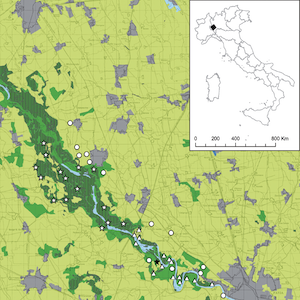Epiphytic lichens of woodland habitats in the lower Ticino river valley and in the “Bosco Siro Negri” Integral Nature State Reserve (NW Italy)

All claims expressed in this article are solely those of the authors and do not necessarily represent those of their affiliated organizations, or those of the publisher, the editors and the reviewers. Any product that may be evaluated in this article or claim that may be made by its manufacturer is not guaranteed or endorsed by the publisher.
Accepted: 9 November 2021
Authors
Epiphytic lichens were surveyed in the “Bosco Siro Negri” Integral Nature State Reserve (province of Pavia, Lombardy, NW Italy), which hosts a well-preserved fragment of oak-elm floodplain forest (Natura 2000 Habitat 91F0). The core woodland fragment hosted only four species on the tree boles, i.e. Lepraria finkii plus the forest specialists Coenogonium pineti, Diarthonis spadicea, and Opegrapha vermicellifera. An additional eight nitro- and photophytic species were recorded on the highest twigs of the canopy. The whole Reserve, including the neighbouring degraded woodlands and poplar plantations, hosted 27 epiphytic lichen taxa. The lower Ticino River valley between Vigevano and Pavia, in which the Reserve is located, was surveyed for epiphytic lichens in an additional 45 sites, including 15 well-preserved oak-elm/hornbeam woodlands (Habitat 91F0), 15 degraded broadleaved woodlands with high occurrence of black locust and 15 poplar plantations. Overall, 32 species were recorded. Well-preserved woodlands had a lower species richness, but they hosted forest specialists not occurring in the other two habitats. Graphis pulverulenta and Lecania cyrtellina are new to Lombardy. Anisomeridium polypori, Diarthonis spadicea, Lecanora expallens and Pseudoschismatomma rufescens are reported from Lombardy for the second time.
How to Cite

This work is licensed under a Creative Commons Attribution-NonCommercial 4.0 International License.










